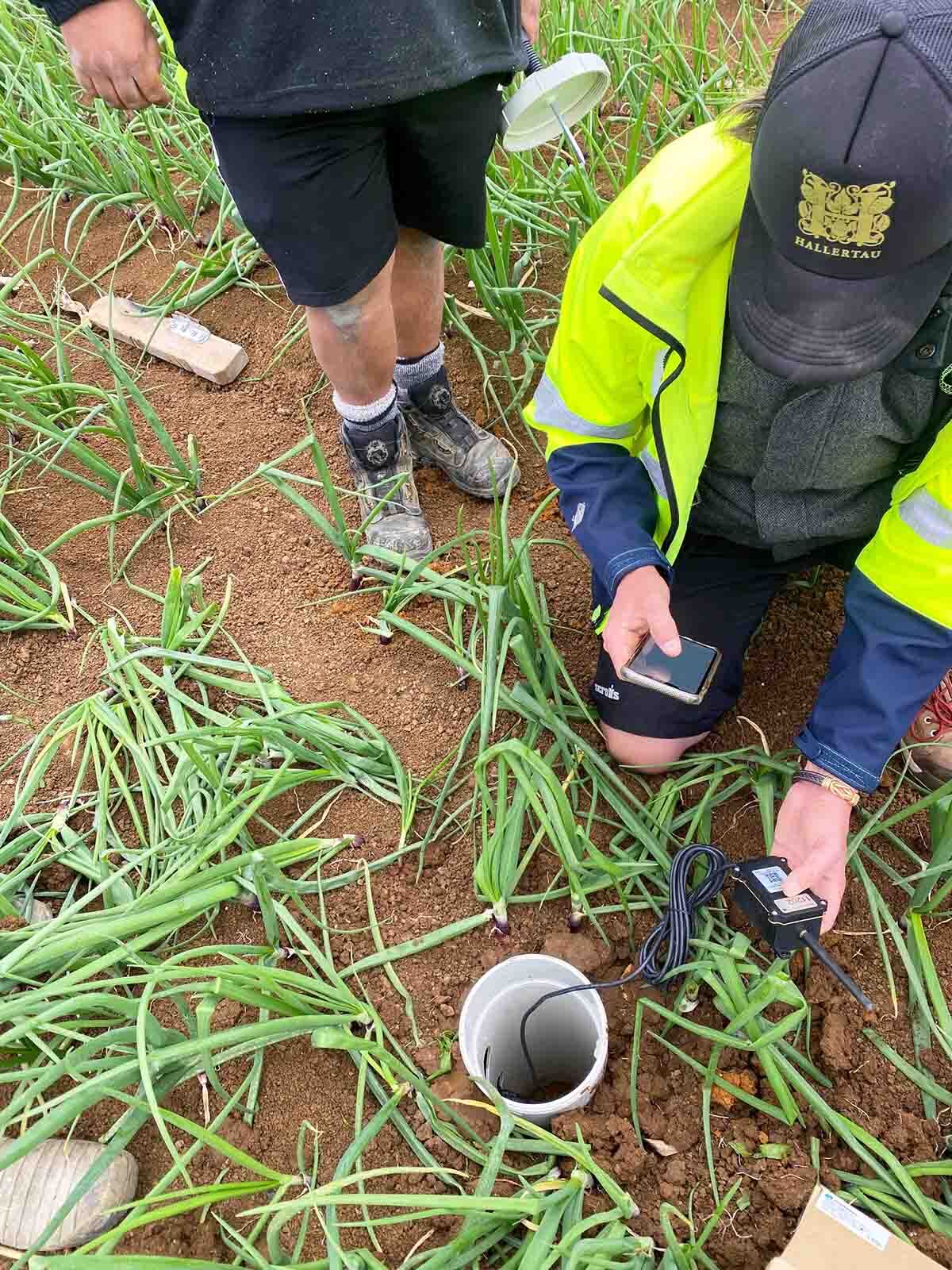Adroit Gets its Hands Dirty in Market Gardening
Hira Bhana is one of New Zealand’s largest potato and onion farmers, producing around 10,000 tons of onions a year, mainly for export. They produce a number of other products as well, including lettuce, cauliflower, and broccoli, on fertile lands in Pukekohe, near Auckland, New Zealand.

Hira Bhana’s management is seeking new tools to give them insights into their farm’s soil conditions and how to optimise the growing of produce – when to fertilise, when to water, and when not to water.
They asked Adroit to deliver an IoT solution to provide both insights and reporting, as well as looking to the future with potential automation and AI integration.
The Situation
At the moment Hira Bhana operates like most other large farming businesses. What they do is largely a manual process, looking at the soil, checking the texture and moisture content with their fingers, and studying weather maps to decide whether to water.
But these manual processes rely on a mix of instinct and experience. Below the surface, the soil might only be dry for the first few centimetres, and then the next 150 mil could be quite, quite wet, or vice versa. In some cases, the type of soil could hold more and moisture for longer, or at other times the soil could be too dry, making plants distressed and vulnerable to disease and pests.
So, understanding soil moisture content right across the farm is very beneficial for the farmer.
Other economic and environmental benefits include understanding how often and how much irrigation is optimal for the plants, so they don’t over-irrigate, causing soil and fertiliser runoff into streams and rivers. It also saves the amount of water used overall. With Auckland’s seemingly perpetual state of drought, all farmers are trying to use less of their water to get to the same amount of crop yield.

Measuring NPK
Beyond the initial soil temperature and moisture measurement, the next sensors Adroit will implementing are to measure EC (electrical conductivity) and NPK (nitrogen, phosphorus and potassium).
These measurements reveal the amount of nutrients in the soil provided by the fertilizer.
Understating how much fertilizer is in the soil, and how much is needed to provide optimum growth allows the farmer to work more efficiently, and get better yield

Optimising for Conditions
Adroit’s first challenge is to help build a soil index. Each plant has a set of needs and a particular growth rate. With potatoes, for example, root growth occurs when soil temperatures are between 10 to 35˚C, but most active root development is at soil temperatures of between 15 and 20˚C.
So Adroit is working with Hira Bhana to build the specific index for each farm. Those numbers will be different for every farm, in every part of the country.
And that’s part of the intellectual property the farmer has in his head. Understanding the way the farmer works with his soil, needs to be converted into the model on the Adroit platform so that it can trigger alerts based on the needs of the plants.
What’s important is to customize those triggers – not based on what some scientist is recommending what those settings should be, but based on the specific farmer’s own intellectual property, that he knows works best for his farm.
Some other things may be specified for compliance or regulation – things like air quality and water quality – but most of these levels are driven by the way that farmer works. Then, it’s really just implementing these settings on our platform.

Equipment and Installation
One is the installation of a new Teralytic NPK sensor that when installed in the ground, will automatically sense and report NPK – phosphorus, potassium and monitor nitrate levels.
Working with Spark NZ, we’ve also deployed the new AWS Spark Gateway as a service. This is a new LoRaWAN network server called Amazon IoT Core for LoRaWAN developed by Amazon Web Services. Spark NZ provides coverage as a service, so we pay a fee per gateway, per month, for the devices that we connect.
For the Soil sensors, Adroit selected the Dragino LSE01, which are very cost-efficient and provide the temperature, moisture percentage, and electrical connectivity of the soil. Battery life on the sensors is approximately 10 years. So we don’t have to go out and service them that often.
Another Adroit innovation is custom developed deployment tubes that contain the sensors, mounted low so they with a stick so that the tractors can see where it is.
And of course, all these sensors provide constant data streams to the Android platform, utilising the LoRaWAN low power, long-range network.

Benefits for the Farmer
Ultimately the main outcome of the Adroit solution is more precision in how the farmer is actually working. The more precise they are, the more cost they’ll save, the more water they’ll save, the better yield they’ll get. We expect there will be other benefits from the analysis of the data over time.
Understanding growth rates, for example, taking the elements of the rain, the sun, the wind and the water into account. Understanding how fast the vegetable is going to grow in that medium. And it also eventually could help farmers to optimize when they harvest for product size or ripeness. Even things like pests. What’s the optimal weather conditions to spray for aphids, or locusts, or whatever the pests are for this kind of farm.
Ultimately AI will play a part in this. A farm in the future will be autonomous in some respects. Where it will know how much rain, how much water it needs to place on the ground, down to the litre, how much fertilizer needs to be put on the plants, down to the kilogram.

